Recent Water Damage Posts
The Science of Drying: How SERVPRO® Ensures Your Property is Dry and Safe
4/10/2024 (Permalink)
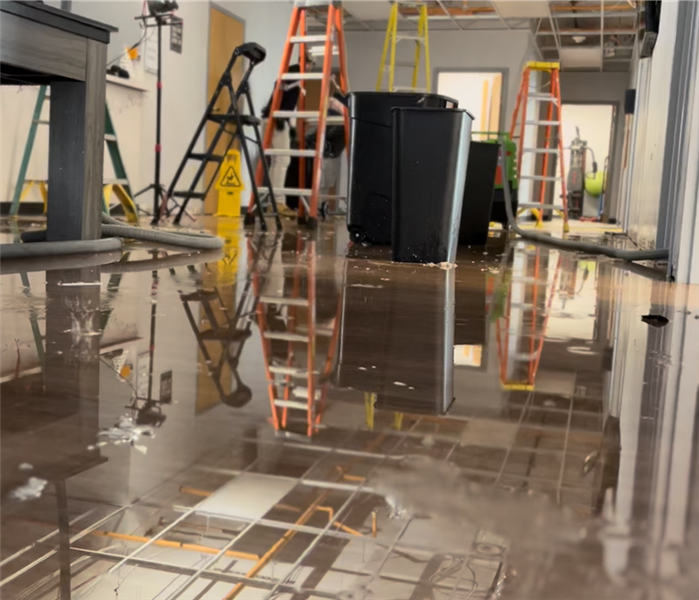 A sprinkler system froze and busted, causing damage and flooding.
A sprinkler system froze and busted, causing damage and flooding.
When disaster strikes in the form of water damage, whether from floods, leaks, or even tornadoes, the clock starts ticking on the potential for secondary damage, such as mold growth and structural issues. That's where the science of drying comes into play, a critical component of water damage restoration that SERVPRO of Northeast Columbus excels.
Understanding Water Damage
The first step in addressing water damage is understanding its extent and your property's specific drying needs. Water can penetrate deeply into structural materials, creating a perfect environment for mold and bacteria to thrive. Quick and efficient drying is essential to prevent further damage and safeguard your health.
The Principles of Drying
SERVPRO's approach to drying focuses on three key scientific factors: air flow, humidity, and temperature. By manipulating these elements, our experts accelerate the evaporation process, effectively removing moisture from air and materials.
- Air Flow: Proper ventilation is crucial in the drying process. SERVPRO® uses industrial-grade air movers to facilitate consistent air flow across wet surfaces, speeding up the evaporation of moisture.
- Humidity Control: Reducing the humidity levels in the affected area is essential. SERVPRO employs professional-grade dehumidifiers to extract water vapor from the air, helping prevent secondary water damage and mold growth.
- Temperature Management: Warm air holds more moisture. SERVPRO's experts carefully monitor and adjust the temperature to optimize the drying process, using heaters if necessary to encourage evaporation and achieve the ideal drying conditions.
Advanced Monitoring Techniques
Precise monitoring throughout the drying process ensures efficiency and effectiveness. SERVPRO technicians use state-of-the-art moisture detection equipment, such as hygrometers and infrared cameras, to monitor the moisture levels within walls, floors, and ceilings. This allows for targeted drying strategies that are both thorough and time-efficient.
The SERVPRO Advantage
What sets SERVPRO apart in the water restoration industry here in Columbus is not just our use of advanced drying technologies, but also our team's expertise. Our professionals are IICRC certified, meaning they're trained in the latest restoration techniques to handle water damage of any scale. SERVPRO's 24/7 emergency service ensures that we're there when you need us the most, ready to begin the drying process immediately to minimize damage and restoration costs.
Is Water Damage An Emergency?
2/17/2022 (Permalink)
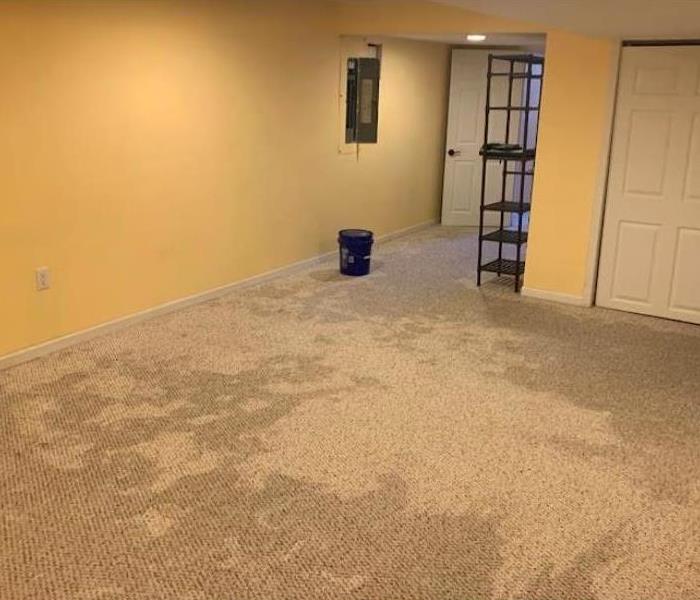 Don't let water damage ruin your home!
Don't let water damage ruin your home!
Having a water damage in your home or business is a very stressful situation. Many things can go through your mind, but how do you know if it is an emergency? If no one is injured, then by definition it is not considered a "true" emergency and 911 usually does not need to be called.
However, it could still be an emergency in regards to your property. The longer that water sits on the building materials, the more possibility there is that secondary damage will occur. Water can seep into wall crevices and down through the floors below. If it is not cleaned up and dried out properly, then the potential for mold growth is high.
If you walk in and see water pouring into your home or business, step 1 is to find the main water shutoff, and to shut off the water.
Also be very aware of these other things that may be affected and could be a potential hazard, such as the electricity supply, gas supply, water damaged electrical appliances, contaminated water (gasoline, chemicals, etc.) or structural damage.
So if you don't call 911, who do you call?
- Local SERVPRO of Northwest Columbus Restoration professionals
- Insurance Agent
- Insurance Company
We work hand in hand with your insurance company to act fast, so we can get your home or business back to normal. We are available 24 hours a day to address these water emergencies. When it comes to water damage, don't take chances. Call us today and get the damage taken care of, the right way!
Why Is My Washing Machine Leaking?
12/30/2021 (Permalink)
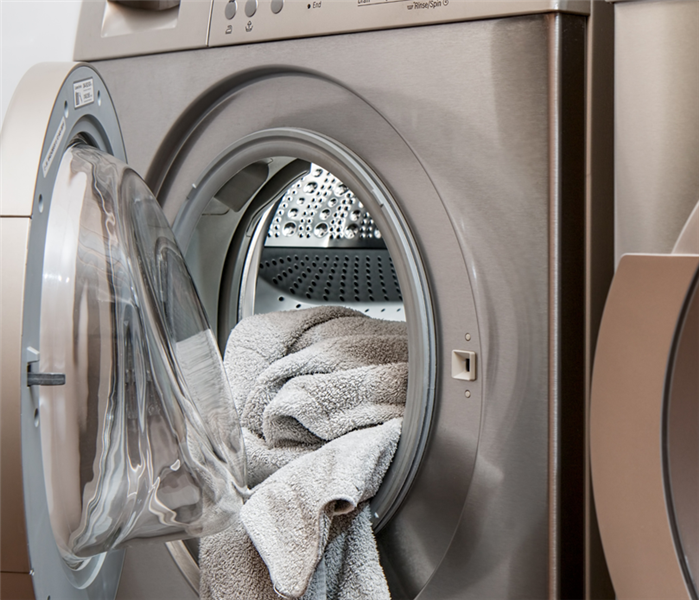 If you experience water damage in your home from a washing machine, call SERVPRO of Northwest Columbus.
If you experience water damage in your home from a washing machine, call SERVPRO of Northwest Columbus.
Over time, wear and tear on your washing machine can leak to internal problems that can result in water leaks. Here are some common reasons why your washing machine is leaking.
- Overloaded washing machine. Overloading a washing machine is the most common cause for it to leak water. Take a look at your user’s guide for load limits and make sure you’re not putting too much laundry in.
- Excessive suds. Putting in too much detergent can lead to excessive suds that can find their way out of your machine and lead to water damage. Water softeners can sometimes increase your detergent’s ability to produce suds.
- Worn out hose gaskets. If you have an old washing machine, or if you have relocated the machine but used the same hoses, the gaskets in those hoses can become brittle over time and leak.
- Problem with the air gap device. The air gap device stops water from back flowing into your home’s water supply. It can crack causing it to leak.
- The fill hoses to the machine are leaking. Be sure that the hot and cold water fill hoses are tightly connected at both sides of the incoming water lines. After a few years, they will become worn out and crack, likely needing to be replaced.
- Damaged incoming water tube. Once the water makes its way inside the washing machine, it is routed through the air gap device by an internal tube can crack and leak.
- Damaged inlet spout. A significant amount of water can leak out of the machine if the inlet spout is damaged or broken free from the mount.
- Blocked or leaking main drain hose. Inspect the hose leading water into the tub or receiving area. Be sure the hose’s connection to the back of the washing machine is properly secured. Ensure the drain hose is not clogged by disconnecting it and running a long wire through it.
- Cracked utility sink or the pipes are leaking. Check near the gooseneck pipes for punctures, cracks or leaks. If you discover rust or corrosion, that could mean trouble.
- Faulty main tub seal. This is the primary water seal between you washing machine’s outer tub and the transmission that turns the tub. The main seal can sometimes leak directly under the tub.
- Broken water pump. The water pump pushes water from the washing machine’s internal tube out. Inspect the drain hose to ensure it is secured to the pump and look out for signs of a loose hose clamp.
- Faulty water supply valves. Inspect the water supply valves connected to the hot and cold lines to ensure they are working. If you will be away from your home for an extended period of time, turn them off to be safe.
- Back-flow from the sewer. Your washing machine drains directly into the sewer if you don’t have a utility sink. When backflow is an issue, call a professional plumber to look at the issue.
The First 48 Hours After a Flood Is Crucial!
12/28/2021 (Permalink)
 Don't wait! Call us today!
Don't wait! Call us today!
Act fast. The sooner you clear the contents out of your basement during a water incident, the more likely you will be able to restore the condition to your items and possessions.
When a finished basement experiences significant water damage, such as a basement flooding or a water pipe burst, timing is everything. Where the sooner you begin the disaster recovery process, the more likely you will be able to restore the condition of your possessions and the finished basement environment.
The first 48 hours are considered the most important time period to react, as it is crucial to preventing further damage to the basement and the items within, as well as preventing a wide spread mold problem. Below are the first steps to take, preferably within these first 48 hours.
- Turn Off the Power. Never enter a flooded basement or touch the flood waters without cutting off the power.
- Call your insurance company. Policies differ. Most require special flood insurance to cover ground water leaks, but homeowner’s insurance may cover damage from indoor plumbing and hot water heater leaks.
- Get the water out as soon as possible. Call SERVPRO of Northwest Columbus to extract any standing water. If there isn’t a lot of water, you might try to get it out yourself, with a “floor sucker” or a shop-vac.
Dry everything out as quickly as possible
To prevent items and building materials from becoming ruined, dry your basement as soon as the water is removed. Ideally, the basement should be completely dry within 48 hours. After that, the potential for mold growth increases considerably. A professional restoration company might help expedite this process. Alternatively, you can consider acquiring a powerful basement dehumidifier.
What's That Smell?! It Might Be Water Damage
11/29/2021 (Permalink)
 If you smell something funny in your home, don't wait! Call SERVPRO of Northwest Columbus today!
If you smell something funny in your home, don't wait! Call SERVPRO of Northwest Columbus today!
Do you know when to be worried about a funny smell? Most new homeowners are not water damage specialists, but the human nose is an excellent tool for sniffing out trouble. Your nose is not the only way to spot water damage in your new home. Our SERVPRO of Northwest Columbus technicians are IICRC certified and can help handle any moisture problems you may discover after moving in.
The sooner you notice a problem, the sooner you can call our team to help mitigate ongoing damages. When you notice a problem, a highly trained SERVPRO professional can assess the extent of your damages. We can use our specialized equipment to remedy the issue fast.
What should you keep an eye out for when you do your spring cleaning? Start at the top. When looking for roof damages, obvious water stains aren't the only problem. Swollen insulation is usually an indication of water retention. Check your flashing (where the roof meets the walls) for cracks and look for missing shingles as well as more obvious signs like holes. Look at door frames and molding. Unusual stains or dark spots on the walls can mean trouble.
Inside, make sure you check your appliances after you move in to be certain they are not leaking where you cannot see easily behind them. Cracked hoses and loose connections can be tricky. Ripples, buckling, and changes in texture can tell you the flooring has a water problem. Remember to trust your nose. If it smells wrong, it probably is.
Outside water damages and mold are often caused by improper drainage. Check your spouts to see that they are clear and make sure you do not have water pooling around the foundation of your new home. At the first sign of damage, you can call SERVPRO.
No one wants to find water damages in their new home this spring. If you do, SERVPRO of Northwest Columbus is available at (614) 261-6666 24 hours a day. Our highly trained team makes your property “Like it never even happened.”
Why Can't I Just Clean Up The Water Myself?
9/28/2021 (Permalink)
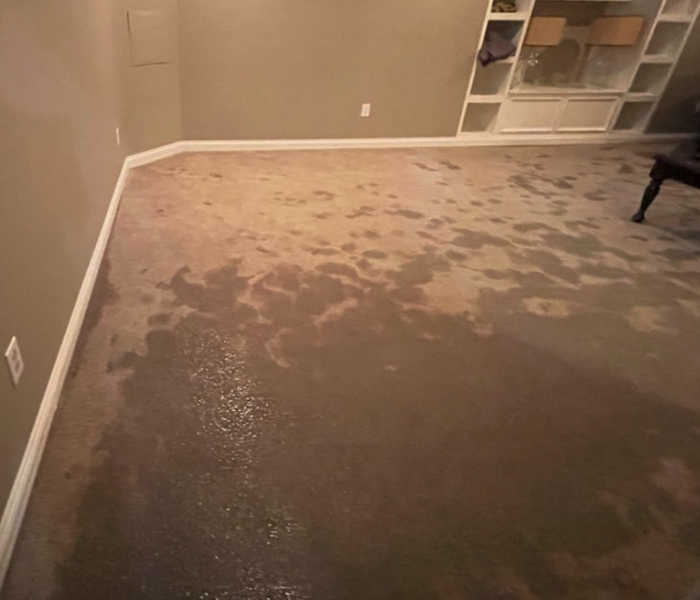 Don't attempt to cleanup alone. Trust our SERVPRO of Northwest Columbus Team to take care of your water loss for you!
Don't attempt to cleanup alone. Trust our SERVPRO of Northwest Columbus Team to take care of your water loss for you!
Once you experience a water loss, your first thought might be to clean it up yourself. To an average homeowner, the cleaning up process seems easy, but in reality it is not.
SERVPRO of Northwest Columbus uses commercial-grade equipment in all of our Columbus water losses, no matter how big or small the loss might be. We have access to a number of resources and professional grade options than anything available at a home improvement or renovation shop. Our specialized technicians are trained follow a careful process that ensures we do not miss anything, providing a safe environment for you and your family to resume living in.
- Inspection and Assessment – Technicians and Project Managers inspect the home using moisture meters to identify all affected areas, making certain we understand the extent of the damage.
- Water Removal & Extraction – We use pumps and smaller vacuum units to draw out the majority of the water in your home.
- Drying the Structure – Technicians use air movers and dehumidifiers to lower humidity and draw moisture out of structural property like wall framing and drywall.
- Cleaning and Sanitizing – Specialists clean off any debris that may have been brought up by the water and deodorize restorable items.
If you have water in your home, contact SERVPRO of Northwest Columbus at (614) 261-6666 immediately. We are here to help you restore your home or apartment to a dry and livable condition.
Are Your Floors Buckling?
9/28/2021 (Permalink)
 Don't let your hardwood floors look like this! Call our SERVPRO Team today!
Don't let your hardwood floors look like this! Call our SERVPRO Team today!
What Causes Hardwood Floors to Buckle?
Floor buckling is the most extreme reaction to moisture in a hardwood floor. Buckling occurs when the wood flooring pulls up from the subfloor, lifting several inches in one or more places. Fortunately, this is not a common occurrence.
If caught early, spot repair and replacement may be possible. Once the standing water is removed, several boards can be taken up from the floor so that the air can circulate across and below the floor. When the floor has dried to a more stable moisture level, repairs can usually be made.
What can our SERVPRO Team do?
- Set up floor protection, drying mats and drying equipment
- Wear PPE
- Clean all affected areas
- Content Manipulation, full Pack out and Storage
- Removal of buckled floorboards
- Replacement of new floorboards
Call SERVPRO of Northwest Columbus today at (614) 261-6666!
Ahh! My Pipes Are Frozen!!
2/23/2021 (Permalink)
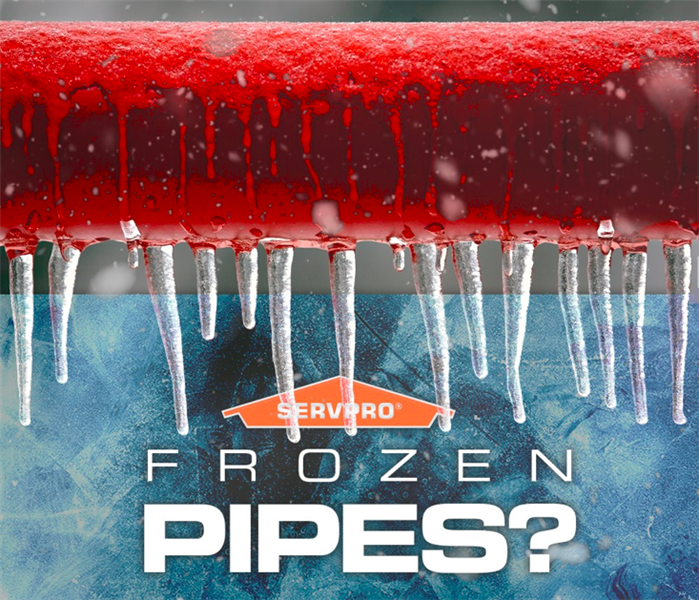 Cold temperatures can lead to frozen pipes, that's why our SERVPRO Team is always here to help!
Cold temperatures can lead to frozen pipes, that's why our SERVPRO Team is always here to help!
The cold temperatures in Columbus can lead to a number of problems for local homeowners. One of which may include frozen pipes. A hard freeze can even lead to broken pipes or water damage in your home. Here are some things you may want to know about what to expect when your pipes freeze.
What To Do When Pipes Freeze
If you have a frozen pipe in your home there are a few things you can do
- Call a professional, like SERVPRO for help
- Keep your pipes open so the water has a place to go when thawed
- Apply gentle heat, like a hot towel or blow dryer, to the frozen area of the pipe
Why Pipes Freeze
During a hard freeze the temperature outdoors can drop so low that the cold can permeate the pipes. Any water inside will then expand. If there is not enough room inside the pipes, then the pressure can cause cracks which will lead to leaks when the water thaws. A water damage professional can help with repairs to your home if the leak causes damage.
Preventing Frozen Pipes
Fortunately, there are a few prevention steps you can take to prevent the freezing of your pipes and subsequent water damage. These steps include draining the water from pipes that may freeze such as a sprinkler line, and disconnecting any hoses from your home. You may also want to close any indoor valves that supply water to outdoor lines. If the weather is especially cold you may want to let your faucets drip a little as moving water is less likely to freeze. It’s also a good idea to keep your home’s temperature above 55 degrees.
When a hard freeze occurs, the water in your pipes can freeze and cause some damage to your home. A professional can help with any repairs and cleanup you may need. If you know that the temperature is likely to get to freezing point, you may be able to take some steps to protect your pipes.
Where Is The Water In Your Home Hiding?
11/11/2020 (Permalink)
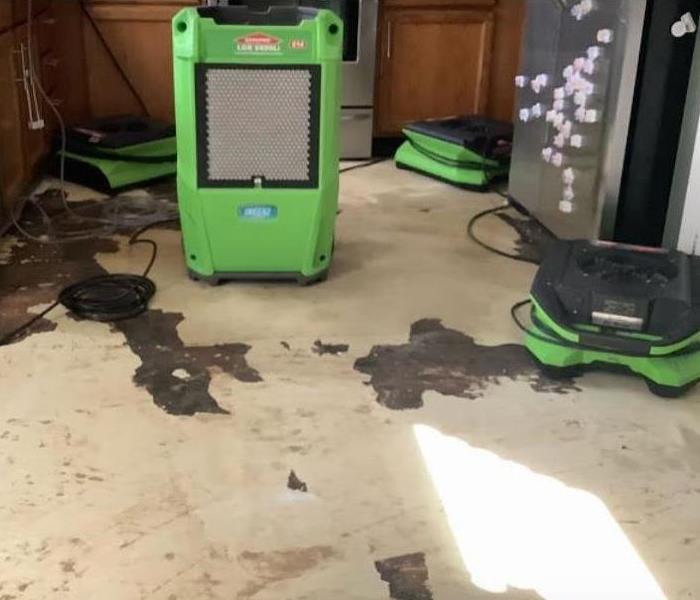 A dishwasher leaked caused water damage to the kitchen in this home.
A dishwasher leaked caused water damage to the kitchen in this home.
Sometimes water damage is sudden and dramatic: a pipe bursting, an appliance malfunctioning. But sometimes it sneaks up on us in the form of a slow leak that can go undetected for long periods of time.
Areas that are prone to cumulative water damage include cabinets under sinks and the areas around AC units, appliances and wobbly toilets. Water can also creep in around exterior doors and windows and under siding. There are many areas in your home that are vulnerable to slow water accumulation and all of them can lead to damaged drywall and flooring, mold, and rot.
If you suspect your home may have a moisture issue, contact the restoration professionals at SERVPRO of Northwest Columbus. Our highly trained technicians have the state of the art equipment and hands on experience to find moisture where it is hidden and create a plan of action to make your home "Like it never even happened." Our SERVPRO Team is available anytime day or night. Call us today at 614-261-6666.
How Our SERVPRO Team Can Restore Your Wooden Furniture
11/11/2020 (Permalink)
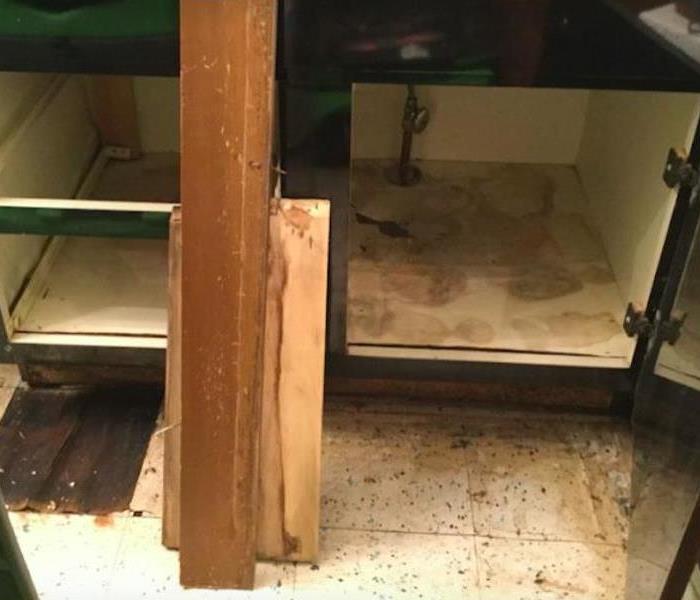 Water damage can cause significant damage to your wooden furniture and cabinets.
Water damage can cause significant damage to your wooden furniture and cabinets.
Water damage can strike any household at any time. There are various causes of water damage, including a burst pipe, an overflowing tub, a leak or a broken appliance. Water can also enter your home from outside sources such as a damaged water main, garden run-off or severe weather. When water leaks or soaks in, it has the potential to cause untold damage to your home and belongings. That is why it is important to contact SERVPRO for help when dealing with unwanted water in your home - “We’re faster to any size disaster.”
There is no doubt that wooden furniture can suffer if there is water damage to your Columbus home. That is bad news for your antique rocker, favorite family dining table or that wooden chest of drawers you inherited from your beloved aunt. The main cause for concern when it comes to wooden furniture is that water can cause it to warp. Wicking up water can also cause swelling of furniture joints and cause them to come unstuck or suffer other structural damage. There is also the risk of water spots or stains on the surface of the item. Chairs, tables, and other items may also crack or warp as they dry.
Our IICRC-experts are experienced in creating the optimum drying conditions for wood furniture. While you are waiting for the specialists to arrive, it is safe to use an absorbent cloth or sponge to pat furniture dry. However, we recommend that you do not wipe or rub it and that you handle it with extreme caution.
SERVPRO experts are trained to assess the damage to your furniture and liaise with furniture refinishers on your behalf if necessary. If it is possible to save the item we set up a drying area for it. The key to getting a great result when drying wood furniture is to dry it slowly and avoid direct heat. We also have wood cleaning products for the removal of minor stains.
Our technicians are equipped with air movers, box fans, and dehumidifiers to help dry out your items. Once we get the temperature to a stable 70-90 degrees F, we use portable low grain dehumidifiers to bring down the humidity around your furniture. Meanwhile, air movers direct air around, over and under the item to increase the rate of evaporation and encourage the drying process.
Do not let water permanently warp your furniture. Call SERVPRO of Northwest Columbus at (614) 261-6666 today for drying solutions.
Saving Your Carpets After A Flood
11/6/2020 (Permalink)
 In some situations, only padding under a carpet needs replacing after incurring water damage.
In some situations, only padding under a carpet needs replacing after incurring water damage.
Carpet replacement can be one of the costliest parts of a water damage cleanup process, but it does not always have to happen. While carpet can easily be damaged beyond possible repair, in many cases SERVPRO can restore your carpet without needing to replace part or all of it. The most important and deciding factor is the severity and type of water damage in your Columbus home - storm flooding and some other forms of damage are typically irredeemable. If the flooding is benign, or if the damage is light overall, we can help save your carpet (and your wallet).
Rapid Drying
Our primary method of softening the impact of water damage in Columbus is our time-tested strategy of mitigation. If the carpet is allowed to stay damp for too long, damage can become permanent, and mold can begin to grow. Within four hours of your first call to us, our personnel should be on-scene to evaluate and respond to damage.
Floodwaters can be extracted before they have time to settle in and cause more severe damage, and we can quickly set up powerful air movers to create powerful, water-removing air currents in your home. Finally, we then use dehumidifiers to take water back out of the air, leaving any scene of water damage completely dry within a short time frame.
Restorative Techniques
Once the carpet has been dried, it likely still needs some restorative processes to be back in top shape. SERVPRO specializes in this, with dedicated cleaning tools and techniques to help maintain color, texture, and integrity of carpeting. During this time, if we determine that a region of carpet is more seriously damaged or otherwise needs replacing, we can typically cut off that spot alone for replacement without removing the rest of the carpet.
SERVPRO of Northwest Columbus is available around the clock to respond to water damage emergencies in the local area. If water damage has hit your home or if you would like to learn more about our services, call us at (614) 261-6666.
Certification is Key to Proper Water Damage Remediation
9/25/2020 (Permalink)
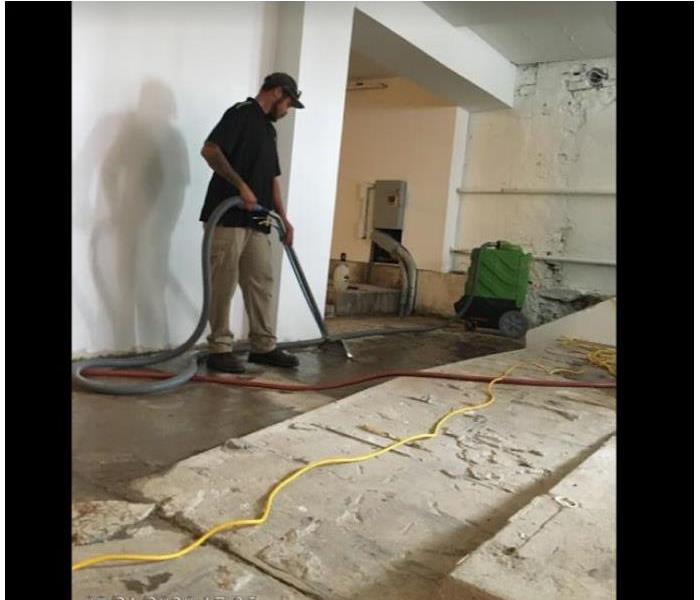 Here is an example of one of our technicians cleaning after a recent flood.
Here is an example of one of our technicians cleaning after a recent flood.
Flooding of any type will ruin some personal possessions (books, papers, and cloth) within minutes. In just a few hours, carpets and flooring can be destroyed as well as furniture. After only a day, walls can become damaged past repair and will have to be removed and replaced before a homeowner or renter can return to their house.
When it comes to water removal for our Columbus neighbors, we require our personnel to meet the high standards established by the Institute of Inspection Cleaning and Restoration Certification (IICRC). SERVPRO also maintains an extensive inventory of specialized equipment built to extract flood water, regardless of the source and where it might be located in your home.
Each team member is trained on this equipment to quickly remove water. Since that is only the beginning, however, we also require them to become certified in five areas as determined by the IICRC. They are:
Water Damage - This overall course covers the many types of water damage and the effects it has on a home. Concentration is given to problems such as overflowing sewers and mold contamination.
Applied Structural Drying - This teaches each technician to use monitoring equipment, moisture extractors and specialized heaters and fans to dry walls and floors that have been under water.
Carpet Cleaning - Our team members learn to identify fabrics and the proper cleaning techniques required for each one. They also are taught to safely use the different cleaning chemicals available to us and how to use them with our vacuums and extractors.
Upholstery and Fabric Cleaning - Techs learn more fiber and cloth identification. Each person also learns about the specific cleaning issues needed to prevent fabrics from bleeding their colors, shrinking or otherwise becoming distorted from having been soaked.
Odor Control - Personnel learn to identify the source of odors caused by flooding or other water damage and the deodorization techniques available to combat them.
In addition to these areas, each technician is trained and qualified on every piece of equipment they might use on each job. Our inspectors also receive additional, specialized training to identify potential problems before they happen.
This is the ideal time to get ahead of those potential problems and call SERVPRO of Northwest Columbus to schedule an inspection. If you may have or suspect damage from previous flooding, call us today. We're ready to serve you!
Don't Wait! Procrastination Can Lead To Floods!
9/25/2020 (Permalink)
 What these homeowners thought a leak that was no big deal resulted in extensive water damage.
What these homeowners thought a leak that was no big deal resulted in extensive water damage.
Putting off repairs until another time can allow leaks in pipes to become larger. These drips can suddenly become much greater, flooding your home. A pipe with a small crack can instantly turn into a broken conduit, sending water by the gallon into your living space. The same goes for joints that are not sealed or soldered correctly and come undone.
If you live in Columbus and this situation happens to you, here are a few things you should know about flood damage. Water can damage anything it comes into contact with, even if the water is clean. Pure water can easily become contaminated by things in your home. Flood damage, just like water damage, gets worse the longer it is allowed to remain present.
Water flowing down your stairway and gushing over the sides can accumulate in many different locations in your home. Water travels downhill, but it also can spread out and cover more surface area when covering something in a horizontal manner, such as it would on a table. Wood absorbs water much more slowly than your carpet, upholstered furniture, or mattresses can, but wood can still soak up enough to be damaged by it.
The water involved in a broken water line is clean, of course, but that does not mean that the water will remain clean. Carpeting, even in the most meticulously kept home, contains many contaminants. Water can whisk that up and carry it along, dropping different things here and there along the path of least resistance. When those same contaminants remained trapped in your carpet's fibers, they did little damage, but now they are free. Contaminants can include microbes such as bacteria and even parasites that may have been inactive until they were immersed in water.
Flood damage can happen with water of any type, clean or utterly filthy. Leaving clean water standing is obviously not conducive to remaining in your home, and SERVPRO can remedy that quickly with a pump truck. However, simply extracting visible water is not enough. Damaged walls must be replaced with new ones, and upholstered furniture must be completely dried and possibly aired out. Your carpeting may need to be removed, and new carpeting installed or, perhaps, cleaned extensively and then dried well. Most often, though, carpeting is usually destroyed by flooding, even if the water was from a clean source.
Because flooding creates a situation in your home that is hazardous to your health and safety in numerous ways, having professionals who are experienced in the complicated cleaning up this type of damage is critical. Incorrect methods, or incomplete ones, can create more harm, not less, in the future. Allowing flooded areas to remain contaminated because they cannot absorb any water, such as the undersides of cast iron tubs, puts your family at risk. Each SERVPRO technician treats your home with respect and care they would pay for their own, and we always take the time required to ensure that each job is complete and done correctly.
SERVPRO of Northwest Columbus is always ready, day or night, to help you take the sting out of flood damage. We know flooding happens without warning, that's why we are always ready to take your call.
How To Know If Your Walls Have Water Damage
2/27/2020 (Permalink)
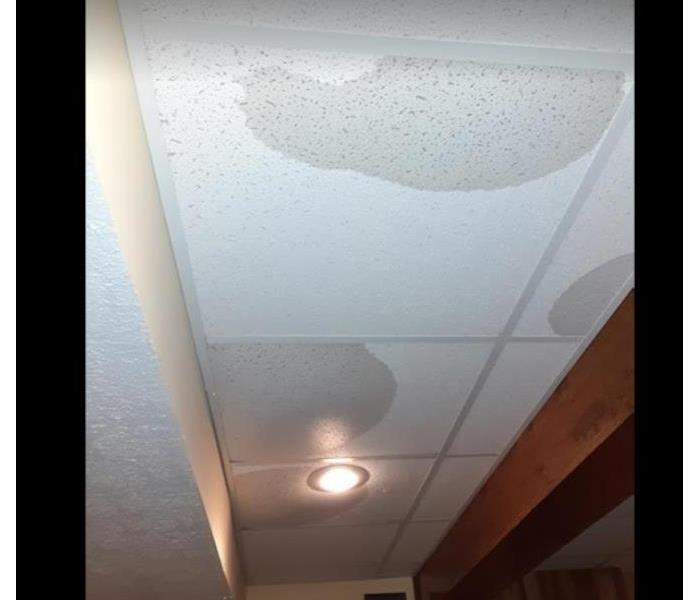 These homeowners knew they had water damage from the water stains.
These homeowners knew they had water damage from the water stains.
Have you ever wondered if your walls have water damage? Sometimes it's not so easy to identify. And, as you know, water losses don't typically happen during convenient hours of the day. It’s not always easy to identify if your walls are damaged, but here are some signs to look for.
Common Signs of Water Damage In Your Walls
- Musty Odor: Water damage can often cause mold damage and/or mildew damage if left undetected. But unfortunately, mold isn't always visible. If you notice a musty odor, that's a sign there may be mold somewhere you don't see. You want to make sure both sides of your walls are checked and tested for mold damage. Most importantly, you'll want to find the source of your water issues so the mold doesn't return and cause more damage.
- Visible Mold Growth On Walls And Baseboards: Always be on the lookout for visible mold growth, it comes in various sizes. Mold infestation can quickly spread throughout a home in 48-72 hours. But you want to be careful because mold may cause harm to you and your family's health, including your pet's. That is why it is very important to contact trained professionals who have the proper training and experience to remove and remediate mold.
- Discoloration: Discoloration is a key indicator that your walls are damaged as a result of water damage. The common colors associated with discoloration are yellow, brown, or copper.
- Peeling Or Bubbling Paint And Wallpaper: The peeling or bubbling of paint or wallpaper is another key indicator that your walls are damaged. It is important to contact trained professionals to access your walls, to prevent further damage from happening down the road.
- Warped Walls: Inspect your walls carefully to see if you have any warped walls. When the sheetrock behind a wall absorbs too much water, it will start to bend and curve, which, in turn, can cause the wall to warp.
- Water Stains: Inspect your walls carefully for any potential water stains. Water stains can easily be missed, especially if they are tiny in size. Since they can start out small, homeowners typically don't notice the water stains until they have increased in size, which, at that time, further damage may have occurred. It's a good idea to inspect around your windows and frames as well.
If you notice signs of water damage in your walls, don't hesitate to call our SERVPRO team! We are always here to help!
Timeline Of Water Damage
11/7/2019 (Permalink)
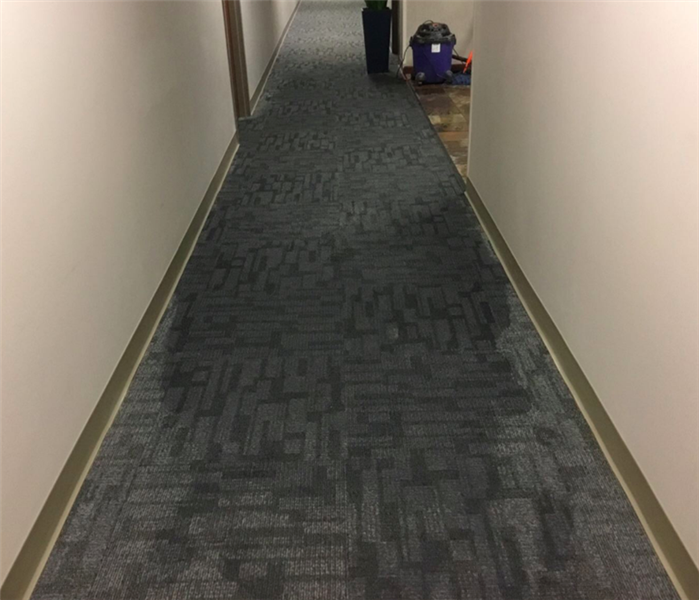 Don't wait! Call us right away if you experience water damage in your home or business.
Don't wait! Call us right away if you experience water damage in your home or business.
When you experience water damage in your home or business, drying it out quickly helps keep the claim cost down.
Within Minutes:
- Water spreads quickly throughout your property, saturating everything in its path.
- Walls, floors, upholstery, and personal contents are absorbed by water.
- Furniture in the path of the water may bleed, causing permanent staining on the carpet.
- Books, photographs and other paper goods start to swell and warp.
Hours 1-24:
- Affected drywall begins to swell and break down.
- Metal surfaces start to tarnish.
- Furniture starts to swell and crack.
- Dyes and ink on paper goods bleed and stain.
- A musty odor lingers in the air.
48 hours to a week:
- Mold and mildew may start to grow and spread.
- Doors and windows start to swell and warp.
- Metal surfaces start to rust and corrode.
- Furniture on the affected flooring warps and shows signs of mold.
- Paint starts to blister.
- Wood floors swell and warp.
- Bio-hazard contamination is possible.
More than a week:
- Restoration time and costs increase dramatically. The replacement of contaminated materials and structural rebuilding may be extensive.
- Structural safety, mold growth, and bio-hazard contaminants pose serious risks to occupants.
Water Damage In Hardwood Floors
11/7/2019 (Permalink)
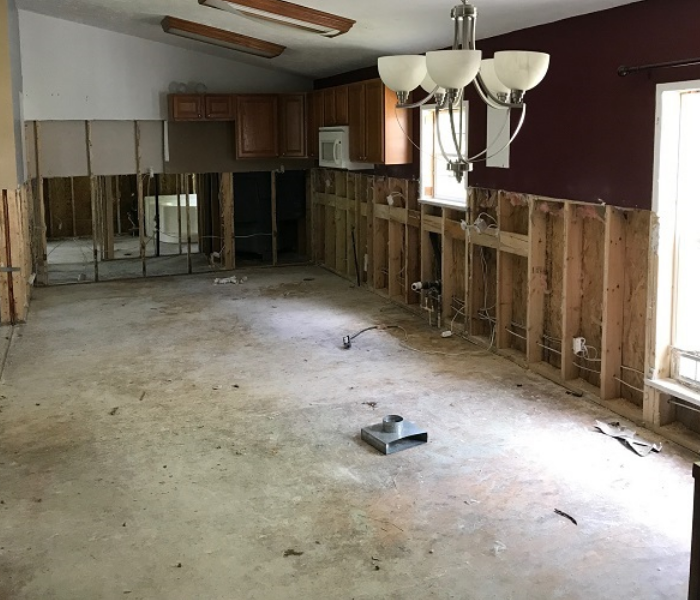 Hardwood floors removed due to a water loss in the home.
Hardwood floors removed due to a water loss in the home.
Hardwood floors are becoming more and more popular due to its required low maintenance. Although hardwoods floors are extremely durable, they can be vulnerable to moisture. If your home has hardwood floors, always be on the lookout for any signs of water damage on your wood flooring.
The first common sign of water damage in hardwood floors is known as cupping. This happens when moisture causes the wood to expand, which then shifts the other boards together and deforms them in the center. Crowning, the opposite of cupping, is another common sign of water damage. Crowning occurs when the boards are pushed together resulting them to raise in the center of the wood boards. Cupping and crowning can both lead to a buckling floor, if left unnoticed. Buckling happens when the floor boards begin lifting from the sub-floor, causing extensive damage to your wood flooring. Other signs to look out for are cracks in the floor, boards separating, or the wood become soft and weak.
If you notice any of these signs in your wood floors, you have wood floor water damage, and need to take immediate action to prevent further damage.
Call SERVPRO of Northwest Columbus right away to begin mitigation services. If the floor is salvageable, we can place drying equipment to repair the damaged floor to its preloss condition.
What To Do And Not To Do After Water Damage
11/1/2019 (Permalink)
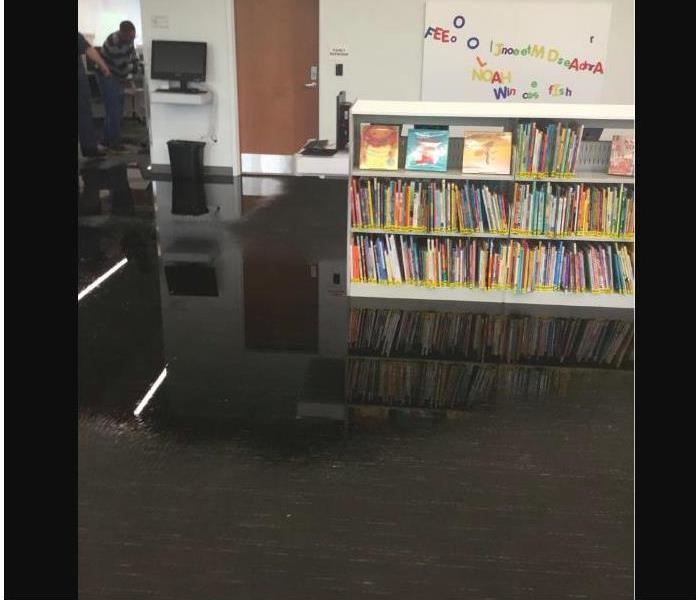 This local library had water damage throughout the whole facility.
This local library had water damage throughout the whole facility.
Water damage can be very devastating to your home whether it is caused by a storm, sewage backup, pipe leak or appliance malfunction. Regardless of how it started, certified and trained professionals should handle water damage emergencies. If you discover water damage on your property, follow these do’s and don’ts list to minimize the damage and start the restoration process earlier.
What To Do:
- Contain the water within the affected area
- Start removing as much standing water as you can through mopping or blotting with a dry towel
- Wipe down furniture
- Put foil between the wet flooring and the furniture legs
- Prop up furniture cushions and pillows
- Remove all rugs away from the affected wet floors
- Turn on your ventilation system to start airing out the affected area
- Move all artwork and pictures to a safe, dry area
- Open closet doors, furniture drawers and luggage to start to help them dry out
- Hang up wet fabrics to dry out
What Not To Do:
- Don’t remove standing water using your vacuum cleaner
- Don’t place newspaper on the floor
- Don’t ever enter a room with electrical or structural damage
- Don’t lift up carpet that is tacked down
- Don’t try to clean up sewage water yourself
- Don’t use electrical appliances while standing on wet floors or carpets
Calling certified and trained professionals should be the first action you take when dealing with a water disaster. If you experience water damage in your home or business, don’t hesitate to call SERVPRO of Northwest Columbus at 614-261-6666. Available for you 24 hours a day, 7 days a week, 365 days a year. We are always here to help.
How To Prevent A Sewer Backup In Your Home
9/25/2019 (Permalink)
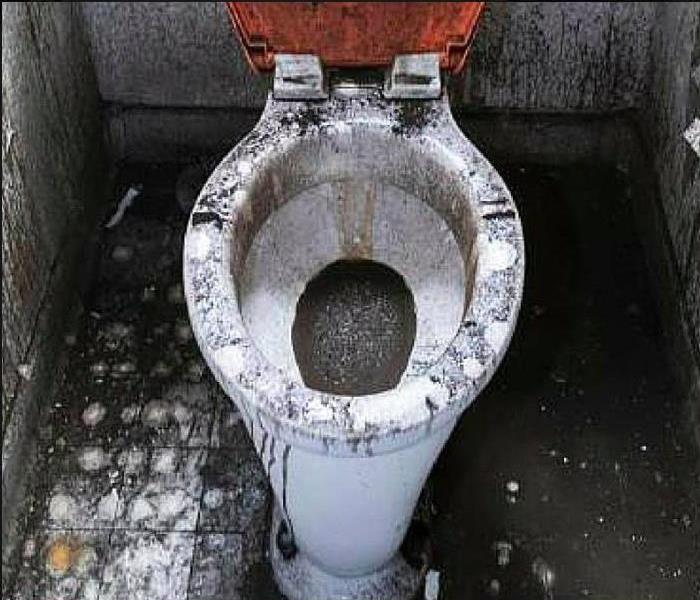 Our Professionals have specialized training and equipment to quickly and safely clean contaminants like sewage.
Our Professionals have specialized training and equipment to quickly and safely clean contaminants like sewage.
Sewer backups can cause major damage to your home. Learn about causes of sewer backups, and what steps you can take to protect your home against sewer problems.
Most Common Causes Of Sewer Back Ups
- Aging Sewer Systems
- Combined Pipelines- Storm water and raw sewage in the same pipeline
- Tree Roots
- Blockages In Sanitary Main
How To Prevent Sewer Backups
- Dispose Of Grease Properly. After cooking oil has been cooled off, it should be put in a heat-resistant container and disposed of properly. Washing grease down the drain is not the way to go. As the grease cools down it will start to solidify either in the drain, owner’s line, or in the main sewer line eventually causing it to clog.
- Dispose Of Paper Product Properly. Paper products such as paper towels, disposable diapers, hygienic wipes, and feminine products do not break down quickly, and can cause a lot of problems down the road in owner’s lateral as well as in the city main.
- Cut Tree Roots Periodically. Have your roots regularly cut by a professional if you notice problems with your tree roots in your lateral.
- Replace Your Line. Replacing your pipes with plastic ones will prevent tree roots from entering your line.
- Fix Illegal Plumbing Connections. It is illegal to connect French drains, sump pumps, and any other flood control systems to your sanitary sewer. The debris will clog your line.
- Install A Backwater Prevention Valve. A backwater valve that is properly installed and maintained allows the sewage to go out and prevent it from coming back in.
If you experience a sewage backup in your home, call SERVPRO of Northwest Columbus at 614-261-6666 today!
Finding Your Water Shut-Offs To Prevent Flooding And Water Damage
9/10/2019 (Permalink)
 SERVPRO technicians help customers locate their water shut off valves in their homes to prevent unexpected flooding.
SERVPRO technicians help customers locate their water shut off valves in their homes to prevent unexpected flooding.
Do you know where your water shut-offs are located in your home? If you can’t answer that off the top of your head then take time to locate those water shut offs in case there is ever a serious leak. A serious leak can easily cause major flood damage to your home’s interior. Learn how to find and turn off your home’s water shut off valves.
Finding The Main Water Shut-Off Valve
The main water shut-off valve is typically located on the perimeter of your home since that is where the water enters your house first. No need to check the central areas or the upstairs, the water usually enters the home either on the ground floor or the basement. Also, search for the valve on the street side because your water main starts at the street and then heads straight to your home.
When you find the valve it will typically be either a knife style or round handle valve. A knife style valve is a straight handle that runs parallel to the pipe. Turn the knife valve a quarter to turn the water off. Knife style valves only turn in one direction, a metal stop prevents the handle from turning in the opposite direction. A round handle valve is similar to a hose faucet. It must be turned several times counter-clockwise to fully shut off the water.
Finding The Plumbing Fixtures Shut-Off Valves
Toilet: This small valve is located below the toilet, against the wall. This shut off will either be a handle that you will turn clockwise to shut off or a push-pull valve, if you are in an apartment, to turn on and off the flow of water to the toilet.
Sink: These valves are located under the sink in the cabinet. There will be two sets of tubes and valves connected to the sink. These valves will also either be handles or push-pulls. Both handles will need to be turned clockwise to shut off the water to the sink.
Washing Machine: Behind the washing machine there should be two valves, one for hot water, and one for cold water. Turn both of the valves clockwise to shut the water off to the washing machine.
Having a serious leak in your home, and knowing how to stop the water from coming in can help prevent extensive water damage. If you experience unexpected water damage in your home, call SERVPRO of Northwest Columbus at (614) 261-6666, we are always here to help!
Different Types Of Water Damage
9/10/2019 (Permalink)
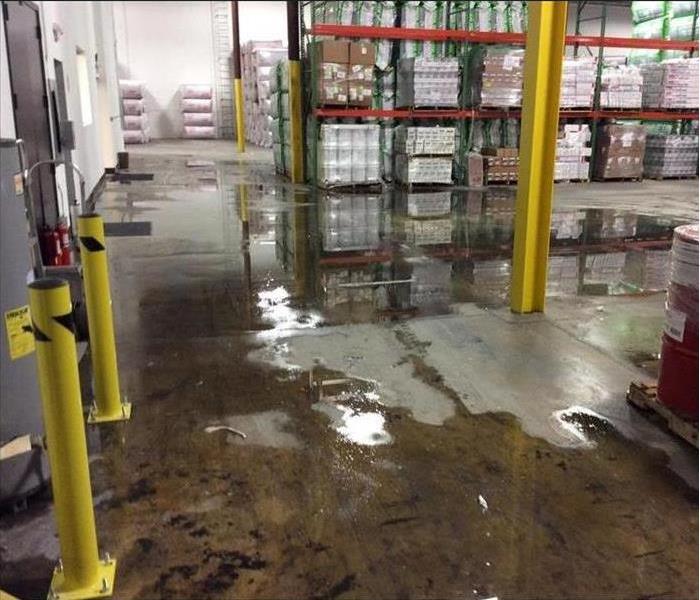 The water loss at this commercial warehouse was caused by a broken pipe, flooding the floor with clean water which is the least harmful.
The water loss at this commercial warehouse was caused by a broken pipe, flooding the floor with clean water which is the least harmful.
The moment you step on wet, soggy carpet your heart sinks knowing you have a water issue in your home. Water damages can cost homeowners both time and money to resolve. There can be many causes of water damage in your home from minor issues to major, costly problems. Water damage can start with a slow leak which takes months to notice to a broken pipe that results is massive amounts of water in a short time period.
No matter how your water loss happened, it is important to realize there are three categories for water which will determine how your loss will be remediated.
Clean Water – Is the least harmful form of damage and does not pose a threat to humans.
- Broken or leaking pipe
- Sink overflow
- Ice maker supply line
- Toilet supply line
Grey Water – Water will contain some microorganisms.
- Sink back up
- Sump pump
- Roof leak
- Leaking air conditioner
- Washing machines, dishwasher, water heaters
Black Water – This can be toxic and may contain bacterial diseases, chemicals, pesticides and microbes.
- Flooding
- Foundation problem
- Gutter problems
- Toilet Bowl overflow
- Sewer back-up
- Water damage that sat over 3 days
While you can not prevent all water damages, there are some precautions you can take to minimize your chances of a water loss as follows:
- Regular inspection and maintenance of your roof.
- Make sure your gutters are clean and installed properly.
- Address any foundation issues promptly. Yard should be sloped 6 inches over a 10-foot span away from your foundation.
- Test your sump pump twice a year by filling your sump pump pit with water to the float level. Make sure your sump pump turns on and the water level goes down.
- Have your air conditioner checked yearly.
- If you are leaving your home for an extended period, turn off your main water line and drain your pipes. This is most important in the winter months where your pipes could freeze if your home loses power.
- When you flush, make sure your toilet drains completely. If you do have an issue, turn the water supply line off and unclog your toilet.
- Inspect and replace worn pipe fittings and hose connections to household appliances once a year.
Call SERVPRO of Northwest Columbus at (614) 261-6666 if you have any questions regarding a water loss. We are always here to help!
Dublin Residents: We Specialize in Flooded Basement Cleanup and Restoration!
6/16/2016 (Permalink)
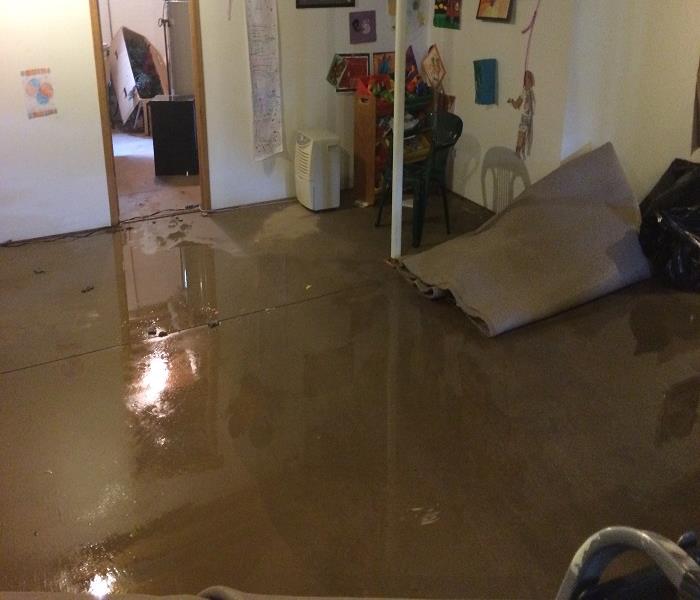 This Dublin home’s basement flooded due to heavy rains.
This Dublin home’s basement flooded due to heavy rains.
A basement can flood at any time, although flooding most often occurs during heavy rainfall. Basements are inherently prone to flooding because they are the lowest level of a building and are normally built partly or entirely below ground level. There are a number of reasons why your Dublin basement could flood, including:
A blocked or failed sewer lateral pipeHeavy rain causes surface water to pool around your homeStorm sewer backupSanitary sewer backupFoundation drainage failureWater supply-line break or hot-water tank failureAnd many moreHave Questions about Basement Flooding?
Call Today -614-888-5700
If flood water is not handled quickly and properly, it can jeopardize your health and safety, and cause severe damage to your home’s structure. Remember, the longer you wait, the worse the problem will get.
The bottom line: a flooded basement can jeopardize your health, safety, and your home’s integrity. It’s worth making a call to SERVPRO of Northwest Columbus and let our trained, professional crews handle the situation safely and correctly. We have earned the trust of hundreds of homeowners, business owners, and property professionals.
We are Flooded Basement Specialists:
We are Available 24 hours/7 days per weekWe’re a Preferred Vendor to many National Insurance CompaniesWe Bill The Insurance Directly – One Less Thing For You To Worry AboutOur Technicians are Highly-Trained in Water Restoration TechniquesWe use s500 IICRC Restoration StandardsAdvanced Inspection and Extraction EquipmentBasement Flooded? Call Us Today – We’re Ready To Help 614-888-5700
Faster to your Dublin Water Damage Event
6/8/2016 (Permalink)
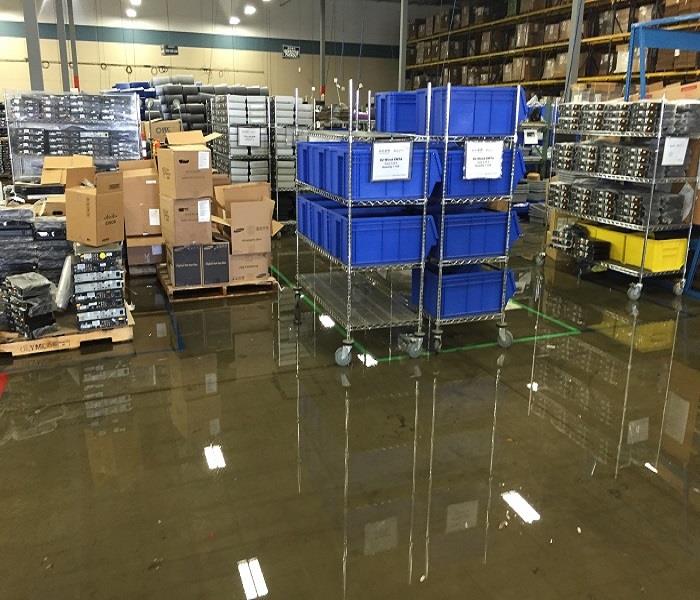 SERVPRO of NW Columbus provides 24 hour fire and water damage restoration service in Dublin
SERVPRO of NW Columbus provides 24 hour fire and water damage restoration service in Dublin
Flooding and water emergencies don’t wait for regular business hours and neither do we. SERVPRO of NW Columbus provides emergency cleaning and restoration services 24 hours a day, 7 days a week—including all holidays.
Faster To Any Size Disaster
Flooding and water damage is very invasive. Water quickly spreads throughout your home and gets absorbed into floors, walls, furniture, and more. SERVPRO of NW Columbus arrives quickly and starts the water extraction process almost immediately. This immediate response helps to minimize the damage and the cleaning and restoration costs.
Need Emergency Service? Call Us 24/7 - 614-888-5700
Water Damage Timeline
Within Minutes
Water quickly spreads throughout your property, saturating everything in its path.Water is absorbed into walls, floors, upholstery, and belongings.Furniture finishes may bleed, causing permanent staining on carpets.Photographs, books, and other paper goods start to swell and warp.Hours 1 - 24:
Drywall begins to swell and break down.Metal surfaces begin to tarnish.Furniture begins to swell and crack.Dyes and inks from cloth and paper goods spread and stain.A musty odor appears.48 Hours to 1 Week:
Mold and mildew may grow and spread.Doors, windows, and studs swell and warp.Metal begins to rust and corrode.Furniture warps and shows signs of mold.Paint begins to blister.Wood flooring swells and warps.Serious biohazard contamination is possible.More Than 1 Week:
Restoration time and cost increase dramatically; replacing contaminated materials and structural rebuilding may be extensive.Structural safety, mold growth, and biohazard contaminants pose serious risks to occupants.About SERVPRO of NW Columbus
SERVPRO of NW Columbus specializes in the cleanup and restoration of residential and commercial property after a fire, smoke or water damage event. Our staff is highly trained in property damage restoration. From initial and ongoing training at SERVPRO’s corporate training facility to regular IICRC-industry certification, rest assured our staff is equipped with the knowledge to restore your property.
Dublin 24 Hour Emergency Water Damage Services
5/25/2016 (Permalink)
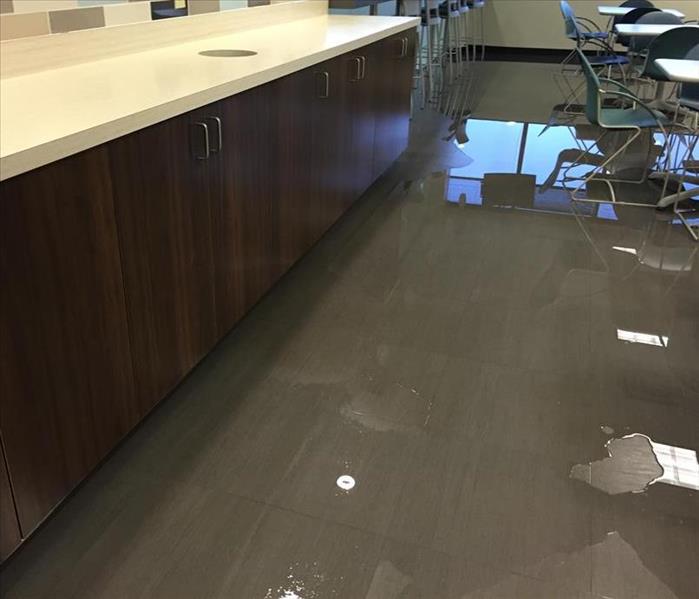 SERVPRO of Northwest Columbus provides 24 hour fire and water damage restoration service in Dublin, Columbus, and Upper Arlington.
SERVPRO of Northwest Columbus provides 24 hour fire and water damage restoration service in Dublin, Columbus, and Upper Arlington.
SERVPRO of Northwest Columbus is available 24 hours a day for water emergencies, large or small. When you are dealing with water damage, immediate action is crucial. A delay of just a few hours can greatly increase the severity of the water damage.
We Answer the Phone Ready to Help
Call Today - 614-888-5700
We understand that when you call us, you may be feeling confused, stressed, and vulnerable. You need an expert to guide you through this crisis. SERVPRO of Northwest Columbus has the specific water damage training and experience to help you through this tough time. We specialize in water damage restoration—in fact, it's the cornerstone of our business.
What to Expect
When you call, we will ask several questions regarding your water damage emergency. These questions will help us determine what equipment and resources to bring, including how many trained SERVPRO Professionals may be needed.
Our SERVPRO Representative will ask several questions:
Your name and contact informationYour insurance information (if applicable)The street address of the water-damaged home or businessWhen did the flooding or water damage occur?What caused the water damage (if known)?Is there electricity available (on-site)?About SERVPRO of Northwest Columbus
SERVPRO of Northwest Columbus specializes in the cleanup and restoration of residential and commercial property after a fire, smoke or water damage event. Our staff is highly trained in property damage restoration. From initial and ongoing training at SERVPRO’s corporate training facility to regular IICRC-industry certification, rest assured our staff is equipped with the knowledge to restore your property.




 24/7 Emergency Service
24/7 Emergency Service




















